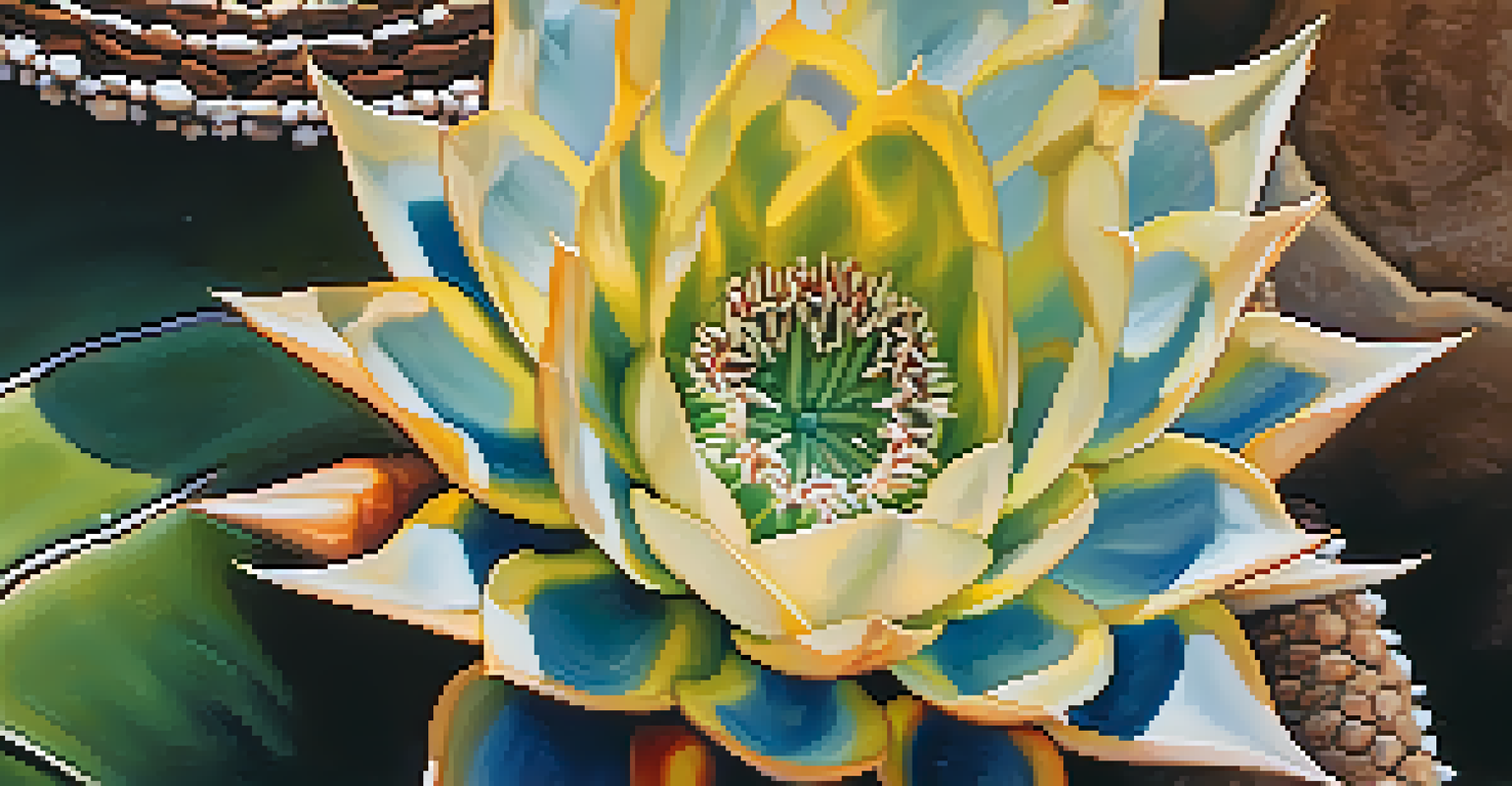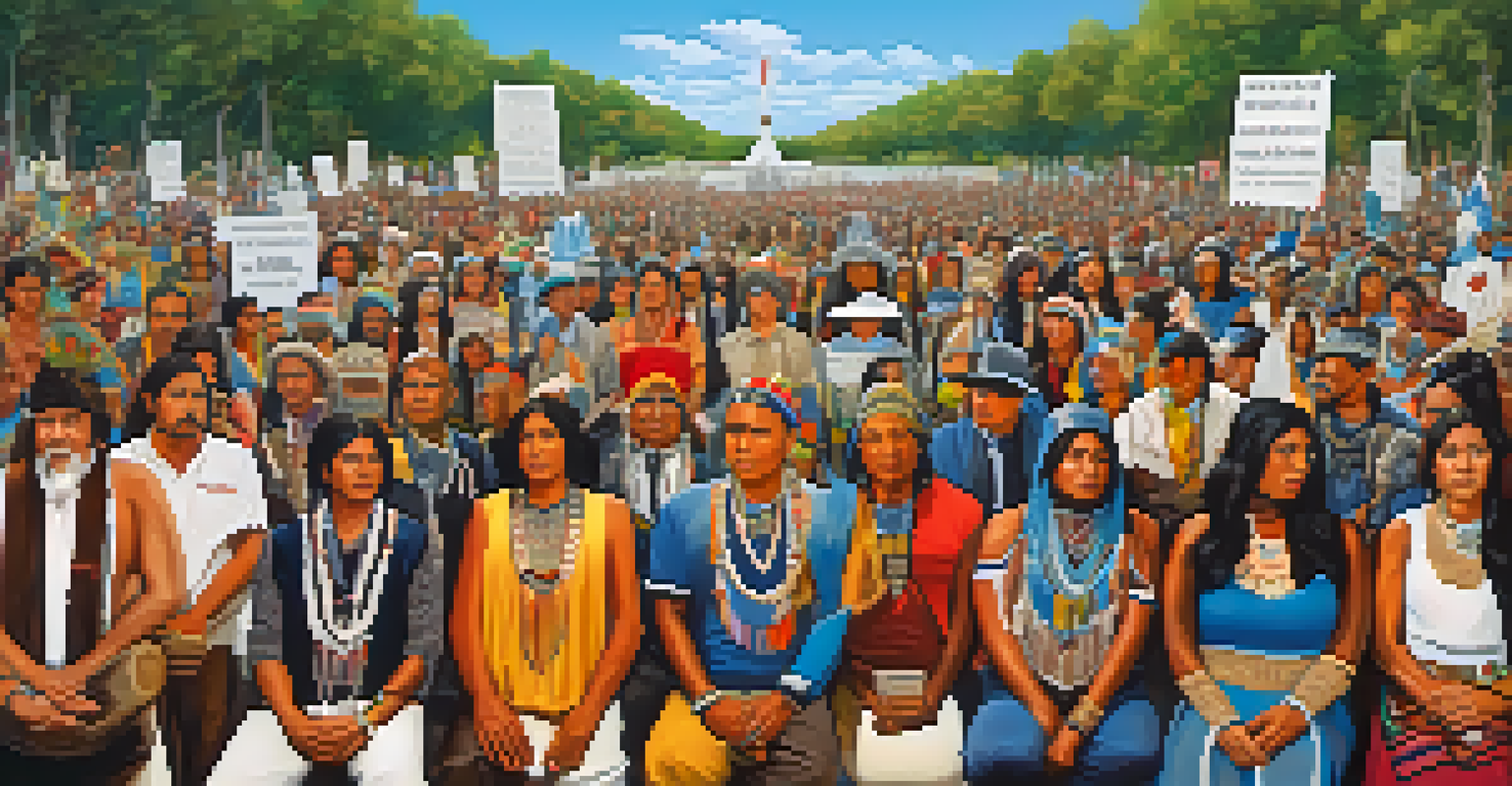Colonial Perspectives on Peyote: A Historical Analysis

The Origins of Peyote Use Among Indigenous Peoples
Peyote, a small cactus native to North America, has been used for thousands of years by Indigenous peoples for spiritual and medicinal purposes. The plant is known for its psychoactive properties, which have played a significant role in various ceremonial practices. This rich history predates colonial encounters, highlighting the deep cultural significance of peyote among tribes such as the Huichol and the Native American Church.
Peyote is a sacred plant that has been used for millennia by Indigenous peoples, offering a profound connection to the spiritual world and their cultural identity.
The traditional use of peyote is not merely about the substance itself; it's intertwined with the community's identity, beliefs, and healing practices. For these Indigenous groups, peyote serves as a gateway to connect with the divine, offering profound insights and guidance. This cultural context is vital for understanding how colonial perspectives would later interpret and often misinterpret these practices.
As colonial powers began to expand their territories, they encountered these Indigenous practices, often with a sense of curiosity mixed with skepticism. The clash of worldviews led to a significant misunderstanding of peyote's purpose and significance, setting the stage for a complex relationship between colonizers and Indigenous peoples.
Colonial Views on Indigenous Spirituality
Colonial perspectives on Indigenous spirituality were often rooted in ethnocentrism, which is the belief that one's own culture is superior to others. This viewpoint led many colonizers to see Indigenous spiritual practices, including the use of peyote, as primitive or superstitious. Such attitudes fostered a dismissive approach toward the rich spiritual frameworks that Indigenous peoples had developed over centuries.

The colonizers often failed to recognize the value of these practices, viewing them through a lens of skepticism rather than understanding. Peyote, in particular, was often associated with notions of savagery or madness, further complicating the perception of Indigenous peoples. This mischaracterization not only marginalized Indigenous cultures but also contributed to policies aimed at eradicating their practices.
Peyote's Spiritual Significance
Peyote has been used by Indigenous peoples for spiritual and medicinal purposes for thousands of years, serving as a vital connection to their cultural identity.
As colonial administrators sought to impose their beliefs, they often attempted to regulate or ban the use of peyote, viewing it as a threat to social order. These actions sparked resistance and resilience among Indigenous groups, who continued to practice their traditions despite external pressures.
The Intersection of Science and Colonialism
The colonial era also saw the rise of scientific exploration, which often intersected with colonial ambitions. Naturalists and other scientists sought to document and study Indigenous plants, including peyote, often without understanding their cultural significance. This scientific curiosity sometimes led to the commodification of peyote, stripping it of its sacredness and reducing it to a mere botanical specimen.
Cultural appropriation is often about taking from others without understanding the significance of what is being taken, which can lead to the erasure of the very cultures that created it.
While some scientists aimed to appreciate the plant's properties, their findings were often used to reinforce colonial narratives. For example, the psychoactive effects of peyote were frequently framed as evidence of the 'backwardness' of Indigenous cultures. This perspective not only devalued the spiritual experiences associated with peyote but also perpetuated harmful stereotypes about Indigenous peoples.
The tension between scientific inquiry and Indigenous knowledge systems created further complexities in how peyote was perceived. As colonial powers documented their findings, they often failed to credit the rich traditions and practices surrounding the use of peyote, leading to a disconnect between cultural understanding and scientific analysis.
Legal and Political Responses to Peyote Use
As colonial influence expanded, so did the legal frameworks governing Indigenous practices, including the use of peyote. Laws were enacted that aimed to control or prohibit the consumption of peyote, often justified by the belief that it posed a threat to societal norms. These regulations reflected a broader trend of colonial governance that sought to suppress Indigenous cultures and assert dominance over their practices.
The legal restrictions on peyote use not only targeted the plant itself but also attempted to dismantle the cultural and spiritual practices associated with it. For many Indigenous communities, the imposition of these laws was seen as an infringement on their rights and a violation of their cultural heritage. This led to significant resistance, as Indigenous groups fought to reclaim their traditions and assert their sovereignty.
Colonial Misunderstanding of Peyote
Colonial perspectives often mischaracterized peyote and Indigenous spiritual practices, viewing them through a lens of skepticism and ethnocentrism.
Over time, legal battles emerged, highlighting the ongoing struggle between Indigenous rights and colonial laws. The fight for the legal recognition of peyote as a sacred substance continues, reflecting the enduring impact of colonial perspectives on Indigenous spirituality.
Cultural Appropriation and Misinterpretation
As peyote gained visibility beyond Indigenous communities, it became a focal point for discussions about cultural appropriation. Non-Indigenous individuals and groups often sought to adopt peyote rituals without a proper understanding of their significance. This appropriation can dilute the cultural meanings and lead to misinterpretations of the practices surrounding peyote use.
The commercialization of peyote and its associated rituals has led to a commodified version of Indigenous spirituality, which can be both disrespectful and harmful. It raises questions about authenticity and the ethics of borrowing elements from a culture without acknowledging its origins. For many Indigenous peoples, this appropriation is a painful reminder of colonial histories that sought to erase their identities.
Moreover, the misinterpretation of peyote's effects has led to a skewed understanding among the broader public. Many see peyote only through the lens of recreation, ignoring its deep spiritual context. This not only trivializes Indigenous practices but also perpetuates stereotypes that undermine the complexities of their cultures.
The Role of Indigenous Activism in Peyote Preservation
In response to the challenges posed by colonial perspectives, Indigenous activism has emerged as a powerful force for the preservation of peyote and its cultural significance. Indigenous leaders and organizations have worked tirelessly to advocate for the recognition of peyote as a sacred plant, emphasizing its importance in spiritual practices. This activism has been crucial in pushing back against colonial narratives that seek to undermine Indigenous rights.
Through grassroots movements and legal initiatives, Indigenous activists strive to reclaim their traditions and ensure that peyote is respected within its cultural context. These efforts not only highlight the importance of peyote but also serve as a broader commentary on the need for Indigenous sovereignty and self-determination. The fight for peyote is, in many ways, a fight for the very identity of Indigenous peoples.
Indigenous Activism for Rights
Indigenous activism has emerged to advocate for the preservation of peyote as a sacred plant, highlighting its importance in spiritual practices and cultural identity.
As awareness of the cultural significance of peyote grows, so does the support for Indigenous-led initiatives. Allies and advocates outside of Indigenous communities increasingly recognize the need to respect and uplift these traditions, creating a more inclusive dialogue around the use of peyote and its place in contemporary society.
Conclusion: Reflecting on Colonial Legacies
The colonial perspectives on peyote reveal much about the broader dynamics of power, culture, and identity. Understanding how peyote has been perceived and regulated throughout history allows us to reflect on the legacies of colonialism that continue to affect Indigenous communities today. It is essential to acknowledge these historical contexts to foster meaningful dialogue and support for Indigenous rights.
As we navigate conversations about peyote, it is crucial to approach the topic with respect and sensitivity, recognizing the deep cultural significance it holds for Indigenous peoples. By listening to and amplifying Indigenous voices, we can begin to dismantle the colonial narratives that have shaped our understanding of peyote and its use.

Ultimately, the story of peyote is not just about a plant; it is a reflection of resilience, cultural identity, and the ongoing struggle for Indigenous rights. Learning from this history can guide us toward a more inclusive and respectful approach to understanding Indigenous practices and their significance in a modern context.